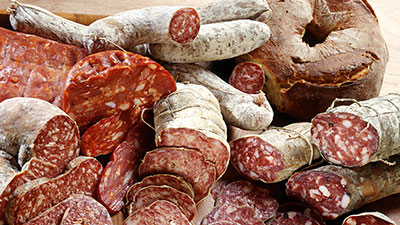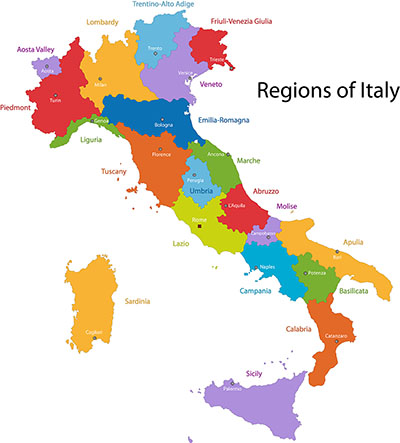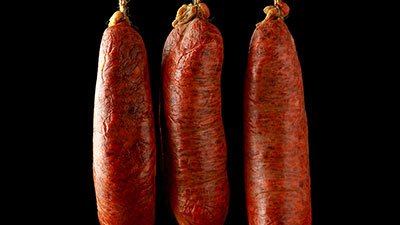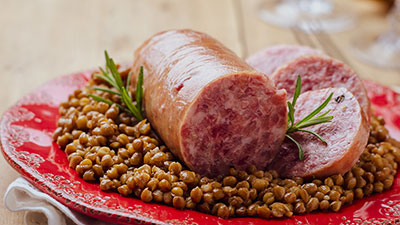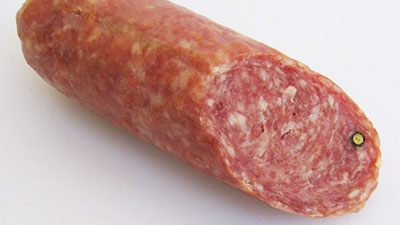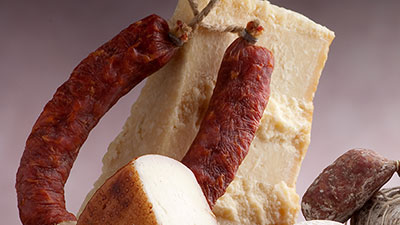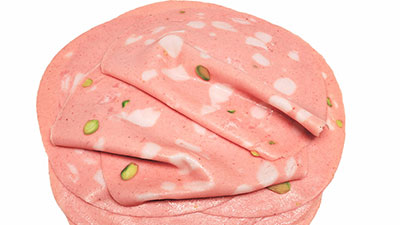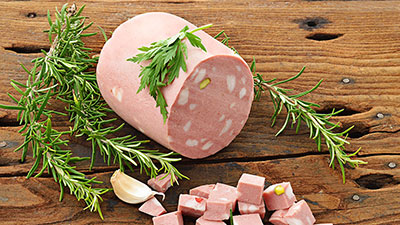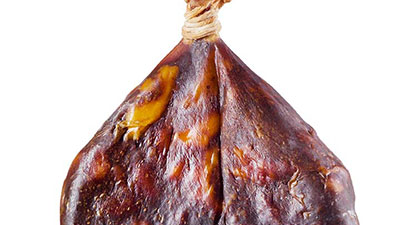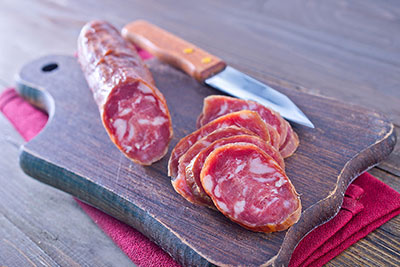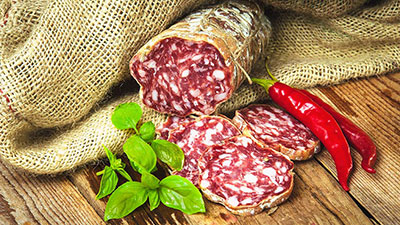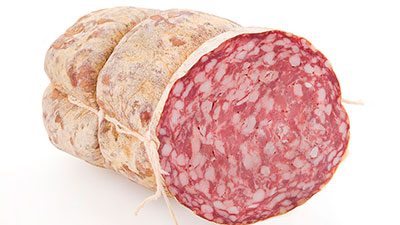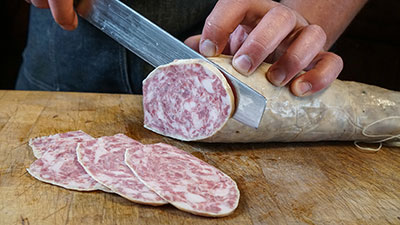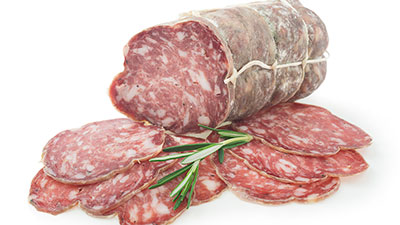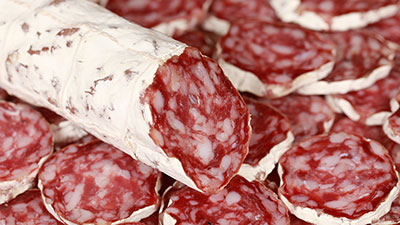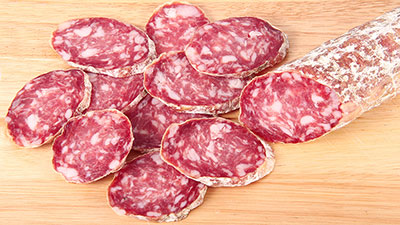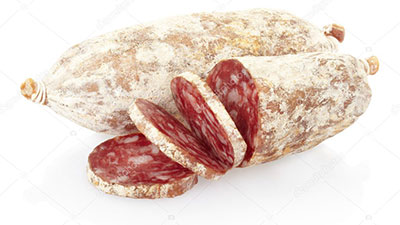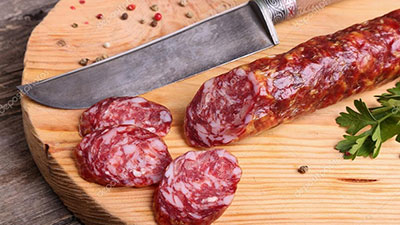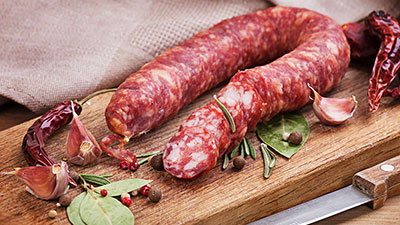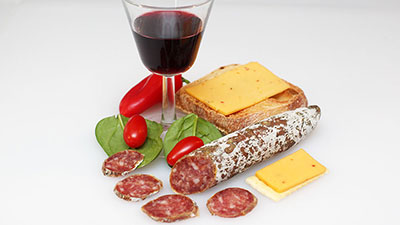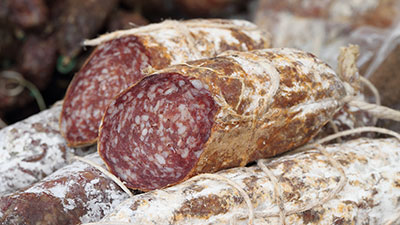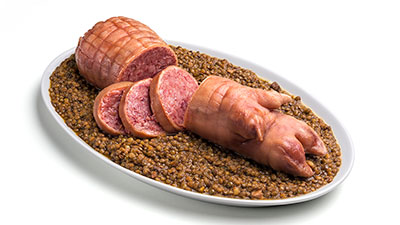Meats and Sausages
Italian Sausages and Meat Products
Italian Sausages are made predominantly from pork meat, pork hard fat, fatty pork trimmings, and spices. The popular spices are black and white pepper, chili pepper, fennel, coriander, nutmeg, cinnamon, caraway, and garlic. Red wine is often added. Italian sausages are generally not smoked. Italian salami is a product that is in a class by itself as its production is based on thousands of years of empirical knowledge. Salami was traditionally made without starter cultures or sodium nitrite; however, nowadays both ingredients are commonly used, even in sausages that carry European Certificates of Origin. Sodium nitrite provides an additional level of safety during the initial stages of production and starter culture guarantees a healthy and predictable fermentation. Although ECO-awarded salamis are still packed into natural casings, more and more products are offered as large diameter packed in tray slices which requires the use of synthetic casings. Italian salami is a slow-fermented product that is characterized by a firm texture, ruby red color, and a buttery cheesy flavor.
Italian processed meats are known as salumi. They can be divided as
- Salumi (whole meats) – bresaola (salted beef), capocollo (neck), coppa (neck and butt cut), culatello (type of ham, an aged fillet of back ham), lardo (salted back fat), pancetta (salted belly), spalla (shoulder), speck (smoked flank), guanciale (pork jowls or cheeks), prosciutto (ham).
- Salami (fermented and dry sausages) – salami, soppressata, salsiccia, mortadella. Salame or salami? - salame is singular, while salami is plural, therefore, it’s a matter of being grammatically correct. English-speaking people have a preference for the plural form salami.
- Insaccati (non-fermented sausages). Those sausages are neither fermented nor dried but submitted to heat treatment after stuffing. They can be subdivided into:
- Salsicce
- Cotechini
There are 20 major regions in Italy that produce a total of 897 meat products and sausages.
Those products can be divided into 4 groups:
- Products awarded European PDO certificate of origin (21)
- Products awarded European PGI certificate of origin (20)
- Traditional Products (Prodotti Agroalimentari Tradizionali) PAT (567)
- Other meat products (289)
There are 20 Italian sausages that have been awarded either DPO or DPI certificates of origin. Such a distinguished product can only be produced in the approved areas by authorized manufacturers although it can be shipped and sold anywhere. In Europe, there are hundreds of mortadella sausages and any butcher can make his own. They all might be good sausages, however, there is only one Mortadella Bologna and one Mortadella di Prato. A French, Polish, or German butcher cannot use the protected names for his own products. A meat plant can use all kinds of legally approved additives and chemicals, the practice which is not allowed for making sausages that were awarded PGI or PDO certificates. The customer may pay an extra premium for such a product but can rest assured that is buying the best there is.
Understanding European Certificates of Origin
When looking for the highest quality products, we have to be aware of the European Certificates of Origin which are awarded to the best European food products. When a locally made product acquires a great reputation, it may apply for a certificate of origin which does not come easy. The product also gets its own logo, a trademark so to speak, which is printed on the label or attached to the product.
The meat products that have managed to obtain certifications are listed below, but keep in mind that there are hundreds of similar products that are not registered and they are all good. For example, there are 9 Prosciutto Ham registrations, but thousands of Prosciutto hams are made every day by meat processors and home sausage makers. They may differ slightly in their formulations but after all, they are all dry hams. Can anyone produce an equivalent ham, let’s say Spanish Jamón Serrano or Italian Prosciutto di S. Danielle? Well, ham imitation can certainly be made but it will be almost impossible to produce an exact replica. With our modern computerized climate control chambers we can simulate the atmospheric conditions that prevail anywhere in the world, so depending on the climate is of lesser importance.
The factor that we can not replicate is the flavor of meat that comes from pigs that grow in a particular region. A pig grows very fast and the texture and flavor of its meat depend largely on its diet. Most of those animals graze freely in fields being fed a strictly controlled natural feed. Spanish pigs roam in oak forests and eat plenty of oak acorns. This alone affects the structure and color of the fat and the proportion of fat to lean.
A person living in a large city is at the mercy of a local supermarket where he obtains his meat. This meat has come from pigs that were raised on a commercial, supplemented with an antibiotics diet, and the pigs were raised in different areas in the fastest possible way in order to obtain the highest return on investment. The quality of the meat will not compare to that which was produced on a small farm in Spain or Italy. This does not mean that one can not produce a wonderful ham at home. The point we are trying to make is that it will be impossible to exactly copy one of those registered European products. The main reason that those products have obtained those certificates is that they are so unique.

PDO - Protected Designation of Origin (PDO) - covers the term used to describe foodstuffs that are produced, processed, and prepared in a given geographical area using recognized know-how.
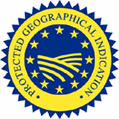
PGI - Protected Geographical Indication (PGI) - the geographical link must occur in at least one of the stages of production, processing or preparation.

Traditional Specialty Guaranteed (TSG) - does not refer to the origin but highlights traditional character, either in the composition or means of production.
The region where the product comes from must prove its uniqueness and show that the product has a long verifiable history. The sausage gets its individual character when it is supported by the name of the region it has originally come from. Those products are made from locally grown animals, often even vegetables, herbs and spices must be grown in the same area. In the case of meat products, no frozen or mechanically separated meats are allowed, sausages are usually packed in natural casings and the local manufacturers get the license to produce them as long as they comply with established regulations for the product. The manufacturer is also often visited by the inspectors from the department that is in charge.<.p>
Italian Sausages Awarded European Certificate of Origin
Ciauscolo PGI
Ciauscolo - is Italian soft sausage known for its unique spreadability, which clearly distinguishes it from other sausages. Unlike all other charcuterie, ‘Ciauscolo’ is not sliced but is ‘spread’ on bread which is due to its high-fat content, finely minced, and the special manufacturing techniques used. The name ‘ciaùscolo, ciavuscolo’ is said to derive from ‘ciabusculum’ or a small meal or snack consumed in small quantities in accordance with rural tradition between breakfast and lunch or between lunch and dinner. in the Provinces of Ancona, Macerata and Ascoli Piceno. Various historical documents refer to the Ciauscolo sausage and prove that the product has been present in the defined area for several centuries
Cotechino Modena PGI
Cotechino Modena - differs from other sausages in that is using a large percentage of pork skin as an ingredient. It is cylindrical in shape, cooked, and easy to slice, with the firm evenly grained pink slices maintaining their shape and it has a characteristic taste. The sausage makers' technical skills, traditionally handed down between those in the trade, are an essential feature of the product, and even today its characteristics are shaped by the importance of environmental and human factors. Unlike the ordinary cotechino sausage, Cotechino Modena PGI must be made to much stricter specifications that correspond to the method used for centuries in the defined geographical area.
Finocchiona PGI
Finocchiona - the Italian name for fennel is “finocchio” so it comes as no surprise that Finocchiona salami is characterized by the aroma of the fennel, which is typical of the regional cuisine and which grows in the production area. The color of the meat slices ranges from red in the lean parts to white/pinkish in the fatty parts, and the fennel seeds and/or flowers may also be visible. The pronounced aroma of fennel and the slight aroma of garlic give the salami its characteristic pleasant smell. It has a fresh and appetizing taste, which is never acidic. The addition of wine to the meat mixture, in accordance with the historical production method, is proof of the strong link with the local area, whose wines are known throughout the world.
Lucanica di Picerno PGI
Lucanica di Picerno - wild fennel (Foeniculum vulgare), is the spice that accounts for the characteristic flavor of Lucanica, other spices such as black pepper (Piper nigrum) and chili (Capsicum annuum) also contribute to the aroma, albeit to a lesser degree. A spicy version of the product is permitted, in which the perceived intensity of the ‘chili’ aroma is greater, although the ‘wild fennel’ aroma must still predominate. The way in which ‘Lucanica di Picerno’ sausages are traditionally hung on special racks when they are being matured gives them their characteristic ‘U’ shape which distinguishes the product to this day.
Mortadella Bologna PGI
Mortadella Bologna - almost every country in Europe produces its own versions of mortadella, in some there is no visible fat, in others there are diced bell peppers, stuffed olives or nuts. All those sausages can be called mortadella, however, there is only one Mortadella Bologna PGI which is made in the authorized region of Italy. In some regions mortadella Bologna is simply referred to as Bologna. Mortadella Bologna must be produced in accordance with a much stricter production process-the one used for centuries in the geographical area - than does ordinary mortadella. Mortadella Bologna is from pork meat and fat, stuffed into natural or synthetic casings, and subjected to prolonged cooking.
Mortadella di Prato PGI
Mortadella di Prato - is Italian sausage made from pork, sea salt, garlic, spices and alchermes liquor which gives the sausage its characteristic character. The texture of the sausage is firm, the internal color dark pink owing to the coloring action of the alchermes, with visible white cubes of fat. The sausage has a penetrating spicy aroma between the hot and pungent, and delicate flavor of the alchermes. ‘Mortadella di Prato’ may be marketed whole, in pieces, or in slices. The area in which ‘Mortadella di Prato’ is produced and packaged comprises the entire territory of the municipality of Prato and the municipalities of Agliana, Quarrata and Montale in the Province of Pistoia.
Salama da Sugo PGI
Salama da Sugo - is a product made from a mixture of seasoned pork meats, packed in a natural pig’s bladder. It is sold as an uncooked edible product after being dried and matured or as a cooked edible product following subsequent heat treatment. The gelatinous nature of the cuts of meat used makes ‘Salama da sugo’ soft and crumbly. Its flavor is derived from the combination of wine and spices used, as well as the processing steps which are carried out under specific environmental conditions. Salama da sugo is processed, prepared, and packaged in the territory of the province of Ferrara, with the exception of the municipalities of Goro, Codigoro, Lagosanto, and Comacchio.
Salami Brianza PDO
Salami Brianza - can only be produced in Lombardia, Emilia Romana and Piemonte regions of Italy. The alpine range that forms the northwest border of the Brianza area brings special climatic conditions the right conditions for the development of microbial flora and fermenting, drying, and ageing sausages. There is a large number of pig and cattle farms in the zone and the meat for Salami Brianza must come from locally raised pigs. Salami Brianza PDO can only be produced in Lombardia, Emilia Romana, and Piemonte regions of Italy. The sausage has ruby-red color, and the flavor is very mild and subtle and never sour.
Salami Cremona PGI
Salami Cremona - is Italian salami produced in Lombardy, Emilia Romagna, Piedmont and Veneto regions of Italy.The production of Salami Cremone is very closely linked with local pig breeding establishments, which go back to Roman times. The raw materials for the product must come from pigs born, raised, and slaughtered in one of the approved regions. The pigs are sent for slaughter between the end of their ninth month and their 15th month. The average weight of each individual sent for slaughter must lie between 144 and 176 kg. Cremona PGI has a deep red color, and a typical spicy fragrance.
Salami di Varzi PDO
Salami di Varzi - has its origin in Varzi, a small city in the Province of Pavia in the Italian region Lombardy, located about 70 km south of Milan. The first records about this sausage go back to the 12th century but today the sausage is manufactured in a wide geographical area. Salami di Varzi PDO must be made from pigs that are reared in Piemonte, Lombardia or Emilia Romana regions. The meat mixture is stuffed into a variety of natural pork casings and the production time will depend on the diameter sausages and may vary from 45 to 180 days. The sausage has a dark red color with visible particles of white fat. The flavor is subtle and sweet, the pleasant aroma is the result of a long maturing process.
Salami d’oca di Mortara PGI
Salami d'oca di Mortara - (Mortara goose sausage) is produced in the area of the Lomellina, a specific area in the Pavia Province of Lombardy Region. As far back as the 15th century, it was linked to the Jewish communities in the area. The goose has been known since Roman times in this area, which with its plentiful springs of fresh water and abundance of vegetation provides an ideal habitat. By the 13th century, Mortara was already famous, as contemporary documents show, for its geese and sausage. From the beginning of the last century, what was a local specialty became known to a bigger public and has continued to enjoy ever-widening fame. The mild delicate taste is typical of goose and the fragrance is marked by the presence of spices.
Salami Felino PGI
Salami Felino - is produced in the whole Province of Parma, which is marked by the presence of both hilly and flat areas, large wooded areas as well as lakes and salt mines. This created ideal conditions for curing meats with salt. On top of that, the exposure to marine air currents and the presence of the right levels of humidity created favorable conditions for drying and maturing meat products. In the Parma hills, it has always been possible to combine the techniques of the plain with the salt of Salsomaggiore (a spa town in Parma known for its salty mineral waters). Only locally raised and officially approved breeds of pigs may be selected for making Salami Felino PGI.
Salami Piacentino PDO
Salami Piacentino - is produced in the province of Piacenza. The area which provides raw meat material is also known for the development of livestock farming which in turn is linked to the widespread cultivation of cereal crops and the well-functioning and highly specialized dairy sector which has encouraged pig farming locally. Meat for Salami Piacentino comes from heavy pigs that are born, raised, and slaughtered locally. Salami Piacentino is produced using lean pork meat with added pork fat at between 10% and 30%. The finished product is cylindrical in shape; its slices are bright red in color, with visible chunks of pinkish-white fat. It has a particular, very intense, rather sweet flavor with a characteristic aroma of sausage meat.
Salami Piemonte PGI
Salami Piemonte - is Italian sausage characterized by soft texture and sweet, delicate flavor, mainly as a result of the short maturing period. The production area of Salami Piemonte covers the entire Piedmont region, which has a temperate, sub-continental, relatively homogeneous climate. The main characteristic of Salami Piemonte is the presence of Piedmont PDO red wine made exclusively from the Nebbiolo, Barbera, and Dolcetto varieties. These typical local wines affect the salami’s flavor and aroma and have always differentiated it from similar products on the market.
Salami S. Angelo PGI
Salami S. Angelo - is Italian salami produced in the municipality of Sant'Angelo di Brolo. The sausage is stuffed into a variety of pork casings and is distinguished by its irregular, cylindrical shape covered with white mold. Its slices are red in color with white particles of fat and it has a delicate and distinctive aroma and a slightly spicy and fragrant taste. Raw materials used and eligible for producing Salami S. Angelo must include fresh meat from selected breeds of local pigs. The raw material used must be delivered to production premises in whole half carcasses (including the head), and the use of frozen or deep-frozen meat is strictly prohibited.
Salamini italiani alla cacciatora PDO
Salamini italiani alla cacciatora - is a small and short Italian salami. The name recalls the days when hunters would put salami in their bags for a day out hunting (‘alla cacciatora’ means ‘hunter-style’). The sausage has a firm compact, uniform ruby red color with evenly distributed specks of fat, delicate and distinctive aroma, mild and delicate taste, never acidic. Based on word-of-mouth accounts, production can be traced back to the Lombard invasions of northern Italy, from where it spread to neighboring areas of central Italy. The production area gradually came to comprise the group of regions in which the ‘Italian heavy pig’ is typically found.
Salsiccia di Calabria PDO
Salsiccia di Calabria - is a typical Calabrian matured sausage, distinguished by its typical U or chain shape. This shape and the composition of its mixture are the determining factors of the product. Of particular importance is the use of meat from Italian heavy pig breeds, whose feed includes plant products specific to the area. The pigs must be raised and slaughtered in the Calabria Region and the production of the sausage must take place there as well. The traditional area of production for ‘Salsiccia di Calabria’ is the Calabria Region which lies in the south of Italy and is characterized by a warm-temperate climate with low rainfall in the wintertime.
Soppressata di Calabria PDO
Soppressata di Calabria - is produced in Calabria which lies in the south of Italy and is characterized by a warm-temperate climate with low rainfall concentrated in the winter period. The meat used in ‘Soppressata di Calabria’ must come from pigs reared in the Calabria Region. The pigs' genetic properties must match those typical of Italian heavy pigs, found in traditional large breeds. The average weight of a pig at slaughter must be at least 140 kg. The skill of the operators in selecting the cuts of meat used to make the mixture, as well as the use of spices and natural aromas, is of major importance in preparing Soppressata di Calabria.
Soprèssa Vicentina PDO
Soprèssa Vicentina - is Italian sausage which is produced in the province of Vicenza. The taste is delicate, slightly sweet, and peppery or garlicky, with very little acidity. Pig farms in the Vicentino use whey (a byproduct from the local cheese industry) because of the characteristics it imparts to the pig meat and hence to the processed pig meat. The Vicentino has traditionally been the home of numerous farmers and/or craftsmen who, by using characteristic methods for rearing pigs and processing and curing the meat obtained therefrom, gave rise to the Soprèssa Vicentina, a truly unique product whose method of preparation has changed very little over time.
Zampone Modena PGI
Zampone Modena PGI - is without a doubt one of the most original sausages. The meat paste is stuffed into natural casings made from the skin of the pig’s foot, complete with the toes, and tied at the top. Zampone Modena originated in Modena but later came to be produced in other regions of central and northern Italy too, where the same know-how in the art of making pure pork sausages of this kind was also passed on and spread. Its historical origin dates back to the early 16th century. The sausage makers’ industriousness and technical skills, traditionally handed down between those in the trade, are an essential feature of this product
Other Popular Italian Sausages
Fegato Pazzo, liver sausageItalian Sausage, fresh sausage
Nduja
Salami di Fabriano
Salami Calabrese
Salami di Verona
Salami Genoa
Salami Lombardia
Salami Milano
Salami Nola
Salami Sorrento
Salsiccia Fresca
Salsiccia Sarda
Sanguinaccio Dolce, blood sausage
Italian Processed Meats Carrying European Certificate of Origin
Breasola della Valtellina PGICapocollo di Calabria PDO
Coppa di Parma PGI
Coppa Placentina PDO
Crudo di Cuneo DOP
Culatello di Zibello PDO
Lardo di Colonnata PGI
Pancetta di Calabria PDO
Pancetta Placentina PDO
Pitina PGI
Porchetta di Aricia PGI
Prosciutto Amatriciano PGI
Prosciutto di Carpegna PDO
Prosciutto di Modena PDO
Prosciutto di Norcia PGI
Prosciutto di Parma PDO
Prosciutto di S. Danielle PDO
Prosciutto di Sauris PGI
Prosciutto Toscano PDO
Prosciutto Veneto Berico-Euganeo PDO
Speck dell’Alto Adige PGI
Valle d’Aosta Jambon de Bosses PDO
Valle d’Aosta Lard d’Arnad PDO
Italian Processed Meats and The Roman Empire
Italian meat products and sausages were made over a thousand years ago and became the first source of meat processing techniques in Europe. One of the reasons the Roman Empire was able to conquer half of the world was the invention of salami and salted meat. Napoleon Bonaparte once said: “the army marches on its stomach” and this is exactly why the Roman soldiers were able to walk many miles each day. Each soldier carried on him dry meats or salami and could satisfy his hunger without interrupting the march. It must be stressed here, that dry salami is immensely rich in calories as it contains only the meat (protein), the fat, and almost no water.
Each legion had between 4,000 and 6,000 soldiers. A Roman soldier was a well-trained fighting machine. He was able to march 20 miles a day, wearing heavy armor and equipment. At the end of the day, Roman soldiers had to build a camp, a ditch, and a wall of wooden stakes. The next day, they marched, fought, or trained again.
Although we don’t think of it, food supplies play a crucial role in any military outfit, especially in the past when refrigeration was unheard of. Without a doubt, the knowledge of producing processed meats and salamis that could last for months without spoiling was one of the factors that contributed to the spread of the Roman Empire.
Without ample supplies Julius Caesar would never have sent his great message: Veni, Vidi, Venci

